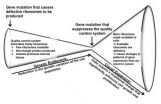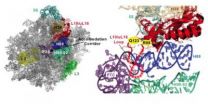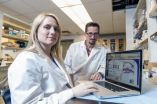(Press-News.org) Ribosomes are essential for life, generating all of the proteins required for cells to grow. Mutations in some of the proteins that make ribosomes cause disorders characterized by bone marrow failure and anemia early in life, followed by elevated cancer risk in middle age. These disorders are generally called "ribosomopathies."
How can ribosomopathies first appear as diseases caused by too few cells, but later turn into diseases caused by too many cells? This paradox has puzzled the scientific community for years. A new study, which uses a genetic approach to examine this paradox, suggests ribosomopathies are caused by a sequence of mistakes at the molecular level.
The study proposes a detailed version of this basic chain of events: Some people are born with or acquire a gene mutation that causes defective ribosomes to be produced. A quality control system in cells eliminates most of the faulty ribosomes. This leaves few ribosomes available for cells to use to produce required proteins, which causes anemia and bone marrow failure early in life. Next, a second gene mutation suppresses the quality control system, making more ribosomes available to cells. However, the available ribosomes are defective and cause changes in gene expression patterns that can result in cancer.
The study will be published the week of March 31, 2014 in the online early edition of the journal Proceedings of the National Academy of Sciences. The research was partly supported by the National Institutes of Health.
"Making ribosomes is a lot like making cars—there is an intricate cellular assembly line where many different parts are brought together to make a complex, fine-tuned, high-performance machine. The assembly line contains quality control inspectors located at critical points in the process to ensure that machines with defective parts do not make it out of the factory and onto the roads," said Jonathan Dinman, professor in the Department of Cell Biology and Molecular Genetics at the University of Maryland. "Imagine a scenario where the only supplier of a specific part produces a defective one. If the inspectors do their jobs, very few new cars will reach the market. This scenario would put most car companies out of business—this is equivalent to bone marrow failure. In the meantime, the demand for new cars increases. This opens the door for an unscrupulous company to fire their inspectors and flood the market with 'lemons.' While good for the company's bottom line in the short term, in the long term the increased rates of accidents and lawsuits wreak havoc."
Dinman collaborated on this study with Kim De Keersmaecker of the University of Leuven in Belgium; Arlen Johnson of the University of Texas at Austin; and Sergey Sulima, who conducted this research as a graduate student in the Department of Cell Biology and Molecular Genetics at UMD and is now a postdoctoral researcher in De Keersmaecker's lab.
The researchers set out to investigate structural, biochemical and other defects in ribosomes that may lead to cancer. The team selected budding yeast as their model system, as assembly of its ribosomes shares many characteristics with human cells, making it a powerful experimental tool. They used a strain of yeast containing a specific ribosomal protein mutation previously identified in patients with a potentially fast-moving form of leukemia known as T-cell acute lymphoblastic leukemia (T-ALL).
When the researchers grew the mutant yeast cells on a petri dish, the cells grew very slowly. The researchers suggest that because of the cells' built-in quality control process, the majority of defective ribosomes carrying the T-ALL mutation do not pass the inspection. This severely limits the supply of ribosomes available to produce proteins, only providing enough ribosomes for cells to barely survive. This supply-and-demand problem hits rapidly dividing cells like blood cells particularly hard, causing anemia and bone marrow failure early in life. Although these disorders can be medically managed with frequent blood transfusions, the bone marrow cells are subjected to an evolutionary phenomenon called "selective pressure," a process that favors reproduction of individuals that resolve problems that limit their ability to thrive. In this case, cells would be favored that could circumvent the mutation that limits the number of available ribosomes and cellular reproduction.
After a few weeks, a group of fast-growing cells appeared on the petri dish containing the mutant yeast cells. The team sequenced the genomes of these cells and found a mutation in a second gene that codes for one of the quality control inspectors. The mutation made the quality control inspector do its job less accurately. This increased the total number of ribosomes available to the cells, enabling cells with the mutation to make more protein, grow quickly, and take over the population. However, the available ribosomes were still defective: their underlying structural problems and biochemical defects never got repaired.
The researchers found that the defective ribosomes tend to make a specific kind of mistake when translating the genetic code. This mistake changes specific patterns of gene expression in cells, consistent with changes that can lead to cancer. The mistakes make an already unstable set of molecules even more unstable. One such set of molecules is important for helping cells maintain telomeres—the DNA at the ends of the chromosomes. The mutant cells exhibited shortened telomeres, a fundamental defect that has been linked to both cancer and aging. The research team proposed two different, but not mutually exclusive, explanations for the changes in gene expression: the mutant ribosomes could be directly changing patterns of gene expression and/or the second suppressor mutation could be driving the changes.
Currently, the researchers are looking for suppressors in human cells that may promote cancer.
"Our yeast work has established a new paradigm that we are now translating to humans," said Dinman. "Once we determine which ribosomal mutations suppress the quality control system in humans, we may be able to identify a potential drug target."
INFORMATION:
This research was supported by the National Institutes of Health (NIH) under Award Nos. GM058859, GM053655 and T32GM080201. The content of this article does not necessarily reflect the views of the NIH.
Dinman Lab: http://dinmanlab.umd.edu/
The research paper, "Bypass of the pre-60S ribosomal quality control as a pathway to oncogenesis," Sergey O. Sulima, Stephanie Patchett, Vivek M. Advani, Kim De Keersmaecker, Arlen W. Johnson, and Jonathan D. Dinman, published the week of March 31, 2014 in the online early edition of the journal Proceedings of the National Academy of Sciences.
Media Relations Contact:
Heather Dewar, 301-405-9267, hdewar@umd.edu
Writer: Abby Robinson
University of Maryland
College of Computer, Mathematical, and Natural Sciences
2300 Symons Hall
College Park, MD 20742
http://www.cmns.umd.edu
Possible explanation for human diseases caused by defective ribosomes
2014-03-31
ELSE PRESS RELEASES FROM THIS DATE:
Oxygen depletion in the Baltic Sea is 10 times worse than a century ago
2014-03-31
This news release is available in German. After several years of discussions, researchers from Aarhus University (Denmark), Lund University (Sweden) and Stockholm University (Sweden) have determined that nutrients from the land are the main cause of widespread areas of oxygen depletion. The results were published on 31 March in the prestigious American journal Proceedings of the National Academy of Sciences.
Nutrients are the villain
The deepest areas of the Baltic Sea have always had a low oxygen content. The inflow of fresh water is actually limited by low thresholds ...
Scientists understand how E. coli clone has become globally distributed
2014-03-31
Scientists have for the first time come closer to understanding how a clone of E. coli, described as the most important of its kind to cause human infections, has spread across the world in a very short time.
E. coli clone ST131 is one of the leading causes of urinary tract and blood stream infections and has crossed the globe at a rapid rate. Worryingly, members of this clone are becoming more resistant to antibiotics. As an indication of scale, more than half of all women will suffer a urinary tract infection at least once in their lives. An international team of scientists, ...
Researchers announce first phononic crystal that can be altered in real time
2014-03-31
Using an acoustic metadevice that can influence the acoustic space and can control any of the ways in which waves travel, engineers have demonstrated, for the first time, that it is possible to dynamically alter the geometry of a three-dimensional colloidal crystal in real time.
The colloidal crystals designed in the study, called metamaterials, are artificially structured materials that extend the properties of existing naturally occurring materials and compounds. The research by academics from the University of Bristol's Department of Mechanical Engineering is published ...
Weaker gut instinct makes teens open to risky behavior
2014-03-31
DURHAM, N.C. -- Making a snap decision usually means following your initial reaction -- going with your gut. That intuitive feeling sprouts from the limbic system, the evolutionarily older and simpler part of the brain that affects emotion, behavior and motivation.
But during adolescence, the limbic system connects and communicates with the rest of the brain differently than it does during adulthood, leaving many adolescents vulnerable to riskier behaviors, according to Duke University researchers.
"We know adolescence is a time of profound social change. It's also ...
New tool helps young adults with sickle cell disease in the transition to adult care
2014-03-31
(Boston) – Child and adolescent hematologists at Boston Medical Center (BMC) have developed a tool to gauge how ready young adults with sickle cell disease are for a transition into adult care. In a new article for the Journal of Pediatric Hematology/Oncology, Amy Sobota, MD, MPH, and her collaborators have shown that a questionnaire geared to the needs of young adults with sickle cell disease can pinpoint areas of need before the patient goes into an adult clinic.
BMC's sickle cell disease transition clinic, which is unique in Boston, was established in 2008 and serves ...
Vibration may help heal chronic wounds
2014-03-31
Wounds may heal more quickly if exposed to low-intensity vibration, report researchers at the University of Illinois at Chicago.
The finding, in mice, may hold promise for the 18 million Americans who have type 2 diabetes, and especially the quarter of them who will eventually suffer from foot ulcers. Their wounds tend to heal slowly and can become chronic or worsen rapidly.
Timothy Koh, UIC professor of kinesiology and nutrition in the UIC College of Applied Health Sciences, was intrigued by studies at Stony Brook University in New York that used very low-intensity ...
Kinder, gentler med school: Students less depressed, learn more
2014-03-31
ST. LOUIS -- Removing pressure from medical school while teaching students skills to manage stress and bounce back from adversity improves their mental health and boosts their academic achievement, Saint Louis University research finds.
Stuart Slavin, M.D., M.Ed., associate dean for curriculum at SLU School of Medicine, is the lead author of the paper, which is published the April edition of Academic Medicine. The problem of depression among medical school students is significant, Slavin said, affecting between 20 and 30 percent of medical students in the U.S., and potentially ...
Poor sleep quality linked to cognitive decline in older men
2014-03-31
DARIEN, IL – A new study of older men found a link between poor sleep quality and the development of cognitive decline over three to four years.
Results show that higher levels of fragmented sleep and lower sleep efficiency were associated with a 40 to 50 percent increase in the odds of clinically significant decline in executive function, which was similar in magnitude to the effect of a five-year increase in age. In contrast, sleep duration was not related to subsequent cognitive decline.
"It was the quality of sleep that predicted future cognitive decline in this ...
Psychological factors turn young adults away from HIV intervention counseling
2014-03-31
PHILADELPHIA (March 31, 2014) – Keeping young people in human immunodeficiency virus (HIV) prevention programs is a major goal in reducing the incidence of HIV, and multi-session interventions are often more effective than single-sessions. But according to a new study from the Annenberg School for Communication, the way these programs are designed and implemented may turn off the very people they are trying to help.
The study, "Motivational barriers to retention of at-risk young adults in HIV-prevention interventions: perceived pressure and efficacy," is published in ...
Research shows link between states' personalities and their politics
2014-03-31
One state's citizens are collectively more agreeable and another's are more conscientious. Could that influence how each state is governed?
A recently published study suggests it could.
Jeffery Mondak and Damarys Canache, political science professors at the University of Illinois, analyzed personality data from more than 600,000 Americans, identified by state, who had responded to an online survey for another research study. They then matched that data with state-level measures of political culture, as identified by other, unrelated research.
The results were striking. ...





